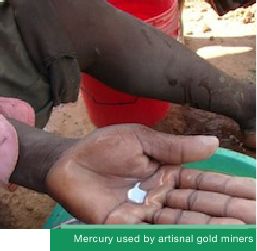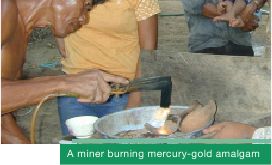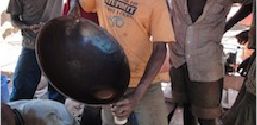Mercury
Estimated Population At Risk At Identified Sites:
8.6 Million People
Estimated Global Impact:
15 to 19 Million People
Introduction
 Mercury is a heavy metal that has significant impacts on human health. Mercury comes in three forms— metallic, inorganic, and organic—each with its own degree of toxicity and particular exposure pathways. Metallic mercury is the pure elemental form of the metal, and is extracted from cinnabar ore. After being heated to above 1,000 degrees Fahrenheit, mercury is refined into its liquid form, which is used in products such as thermometers, electricity switches, dental fillings; in the production of caustic soda and chlorine gas; and is used to extract gold from ores containing gold. Another primary form of the metal is organic mercury, most commonly known as methylmercury, and produced when elemental mercury combines with carbon. This is the form of the pollutant that can contaminate food chains.
Mercury is a heavy metal that has significant impacts on human health. Mercury comes in three forms— metallic, inorganic, and organic—each with its own degree of toxicity and particular exposure pathways. Metallic mercury is the pure elemental form of the metal, and is extracted from cinnabar ore. After being heated to above 1,000 degrees Fahrenheit, mercury is refined into its liquid form, which is used in products such as thermometers, electricity switches, dental fillings; in the production of caustic soda and chlorine gas; and is used to extract gold from ores containing gold. Another primary form of the metal is organic mercury, most commonly known as methylmercury, and produced when elemental mercury combines with carbon. This is the form of the pollutant that can contaminate food chains.
Mercury naturally enters the environment through the breakdown of minerals into soil, which is then dispersed through the movement of air and water. Since the start of the industrial revolution in the 18th century, the release of mercury into the environment has been heavily amplified. Currently, the anthropogenic release of mercury accounts for up to two-thirds of the total mercury in the environment. [24]
Other common sources of mercury pollution in these countries include industrial mining, chemical manufacturing, solid waste disposal, and metals smelting. Most of these activities involve the heating of mercury, which releases it into the air in vapor form. The mercury is then transported in dust by wind. Mercury can settle into soil or surface waters through rainfall, and often is washed away from these sites along with tailings and sediments into local water bodies. Once in an aquatic ecosystem, elemental mercury can be transformed into methylmercury—a powerful neurotoxin—by bacteria, and can bioaccumulate and move up the food chain.
People are commonly exposed to mercury through the inhalation of vapors produced through the burning of mercury in these various industrial activities; however, many are also exposed to methylmercury through the consumption of contaminated food products such as fish. Once mercury enters the human body, it can permanently damage the brain, kidneys, and the development of a fetus. Exposure to methylmercury can cause arthritis, miscarriages, respiratory failure, neurological damage, and even death. Children are most at risk of mercury exposure, especially in regions adjacent to small- and large-scale gold mines.
Common Exposure Pathways and Health Risks
Mercury is released into the environment both as a vapor from burning processes and as a liquid that contaminates water and soil. In occupational settings such as mining sites, workers are primarily exposed to elemental mercury in the form of these vapors—it is estimated that around 80% of exposure to mercury is through this pathway. [25] People are also exposed to mercury through dermal contact, as the contaminant can be absorbed through the skin.
The use of mercury in industrial processes and products also allows small amounts of the heavy metal to contaminate soils and local water bodies. One study of small-scale mining in Peru estimated that one or two grams of mercury were being released into the surrounding environment for every gram of gold produced. [26] Mercury is also released into the environment through the produciton and disposal of fertilizers, fungicides, and solid wastes. These materials allow mercury to then settle in rivers, lakes, and streams, where it can remain for years.
Once in a water system, microorganisms process mercury, an activity that initiates the contamination of ecosystems and food chains by converting elemental mercury into methylmercury. Methylmercury can then accumulate in the fatty tissues of fish, mollusks, and other food sources, upon which many communities depend for their livelihoods. Additionally, some studies have found that livestock feeding on mercury-contaminated fields can also become a potential source of exposure to humans. [27]
Each of these pathways exposes people to the acute and chronic effects of mercury. Exposure can cause severe developmental problems in children and fetuses, kidney problems, arthritis, memory loss, miscarriages, psychotic reactions, respiratory failure, neurological damage, and death. In terms of the magnitude of these impacts, one study found that over half of artisanal gold miners in two regions of Indonesia were diagnosed with chronic mercury intoxication. [28] However, even less exposed groups—mineral processors and the general population living near mining sites—were also found to have high levels of mercury exposure.
As the most direct pathway, the inhalation of mercury vapor allows the pollutant to reach the brain, potentially causing permanent damage to the brain, the kidneys, and fetal development. Children are the most vulnerable population to mercury exposure, and are particularly at risk for developmental problems. Research also suggests that breast-feeding can be a source of mercury exposure to infants. [29]
There is a growing body of scientific evidence that mercury exposure can negatively impact the human immune system. [30] [31] In particular, one study has observed an association between immune system disorders and exposure to both organic and elemental mercury. [32] Fieldwork in northern Brazil, where artisanal gold mining is widespread, shows preliminary results that indicate an association between these immunologic changes and vulnerability to infectious diseases such as malaria. [33]
Industrial Sources of Mercury – Artisanal Gold Mining
Industry Overview
 Artisanal mining (ASM) refers to informal operations that extract and process metals on a small, rather than industrial, scale. The most prevalent form of informal mining is artisanal gold mining. This sector is responsible for nearly 20 % of global gold production, which equates to 330 tons of the product. ASM is concentrated in low- and middle-income countries such as Mozambique, where it accounts for up to 90% of national gold production. [34]
Artisanal mining (ASM) refers to informal operations that extract and process metals on a small, rather than industrial, scale. The most prevalent form of informal mining is artisanal gold mining. This sector is responsible for nearly 20 % of global gold production, which equates to 330 tons of the product. ASM is concentrated in low- and middle-income countries such as Mozambique, where it accounts for up to 90% of national gold production. [34]
To separate the gold out of the gold-laden silt, ASM miners introduce mercury into the silt, which binds to the gold and forms a hardened mercury-gold amalgam. The remaining silt is then washed away, and the amalgam is heated with blowtorches or over open flames to evaporate the mercury, leaving be hind pure gold. This burning process is often done in homes, and thus releases mercury vapors into the surrounding air. Additionally, when mercury is used in ASM, small amounts of the metal are often washed away along with unwanted tailings or sediments into local water bodies.
Once mercury enters the waterways of a region, it begins to be absorbed and processed through various levels of the ecosystem, starting at the base level of bacteria. The bioaccumulation of mercury transforms elemental mercury into methylmercury, one of the most dangerous toxins that can contaminate a food chain.
Global Context
UNIDO estimates that between 10 and 15 million people—including 4.5 million women and 600,000 children—obtain their livelihood through ASM. [35] Studies have found that the majority of women miners work in the amalgam-processing phase, where they are most susceptible to mercury exposure. [36] Research from Blacksmith Institute’s ongoing assessment of polluted places indicates that the majority of artisanal mining sites are located in Southeast Asia, Africa, and South America.
Most artisanal miners are from socially and economically marginalized communities, and turn to mining in order to escape poverty, unemployment, and landlessness. [37] The cycle of poverty brings miners into hazardous working conditions where these individuals also face persecution by the government, the risk of mineshaft collapse, and toxic poisoning from the variety of chemicals used in the amalgamation process. Despite this combination of dangers, artisanal mining operations continue to spread as the demand for metals increases and other livelihoods, such as farming, become less economically viable in these regions.
UNIDO estimates that the methods used in ASM to extract and process gold results in the release of an estimated 1,000 tons of mercury per year, which constitutes about 30% of the world’s anthropogenic mercury emissions. [38] Additionally, as much as 95% of all mercury used in artisanal gold mining is released into the environment, constituting a danger to economies, environments, and human health. [39]
Exposure Pathways from Artisanal Mining
 ASM releases mercury into the environment as a vapor during the amalgam burning process. ASM workers and their immediate family members subsequently inhale these toxic vapors. One study in Tanzania found that out of all workers engaged in the ASM sector, those working directly with amalgam burners had the highest levels of mercury in their blood, hair, and urine. [40]
ASM releases mercury into the environment as a vapor during the amalgam burning process. ASM workers and their immediate family members subsequently inhale these toxic vapors. One study in Tanzania found that out of all workers engaged in the ASM sector, those working directly with amalgam burners had the highest levels of mercury in their blood, hair, and urine. [40]
Using mercury in the amalgam process also allows small amounts of the heavy metal to contaminate soil and local water bodies through discarded tailings and sediments. [41] When soil becomes contaminated with mercury, the pollutant can also impact food sources. One study of a small-scale gold mining site in China found that the total elemental mercury concentrations in consumed vegetable and wheat samples significantly exceeded the Chinese safety limit. [42] And as noted with methylmercury, fish and shellfish also become a source of exposure once rivers and lakes are contaminated with elemental mercury.
What is Being Done
Each of Blacksmith Institute’s several mercury programs around the world share a common objective: to introduce mercury-reducing technologies to artisanal mining communities in order to lessen its impact on human health and the environment. Blacksmith, in conjunction with UNIDO’s Global Mercury Project, has initiated a series of appropriate technology demonstrations to limit the mercury emissions affiliated with ASM. Dr. Marcello Veiga, Chief Technical Advisor to the Global Mercury Project, developed a groundbreaking and inexpensive adaptation of retort technology, which typically costs between $3 and $8 US. Through the use of this device, mercury can be used in the gold extraction process without contaminating the environment.
There are a number of cleaner technology alternatives to current methods of mercury amalgamation. The use of retorts during the mercury burn-off stage is a simple and highly cost-effective method of controlling the release of mercury into the environment by allowing for the efficient capture and reuse of mercury and minimizing occupational exposure. Experience has shown that the largest barrier to the uptake of such technology is education. Blacksmith is working to break the cycle of dangerous mercury use by supplying ASM miners with the education and technology needed to minimize their exposure to mercury and its release into the environment.
Footnotes
[24] U.S. Department of Health and Human Services. “Toxicological Profile for Mercury.” Georgia: Agency for Toxic Substances and Disease Registry, 1999.
[25] Ibid.
[26] Earth Report. “Slum at the Summit.” Television Trust for the Environment. Available at http://www.tve.org/earthreport/archive/doc.cfm?aid=1623, 2004.
[27] R.T. Chibunda and C.R. Janssen. “Mercury Residues in Free-Grazing Cattle and Domestic Fowl form the Artisanal Gold Mining Area of Geita District, Tanzania.” Food Additives & Contaminants: Part A: Chemistry, Analysis, Control, Exposure & Risk Assessment 26.11 (2009): 1482–1487.
[28] St. Bose-O’Reilly, et al. “Health Assessment of Artisanal Gold Miners in Indonesia.” Science of the Total Environment 408.4 (2010): 713–725.
[29] St. Bose-O’Reilly, et al. “Mercury in Breast Milk – A Health Hazard for Infants in Gold Mining Areas?” International Journal of Hygiene and Environmental Health. 211.5–6 (2008): 615–623.
[30] Li Sweet and J.T. Zelikoff. “Toxicology and Immunotoxicology of Mercury: A Comparative Review in Fish and Humans.” Journal of Toxicology and Environmental Health. Part B, Critical Reviews 4.2 (2001): 161–205.
[31] P. Moszczynski. “Immunological Disorders in Men Exposed to Metallic Mercury Vapour. A Review.” Central European Journal of Public Health 7.1 (1999): 10–14.
[32] R.M. Gardner, et al. “Mercury Induces an Unopposed Inflammatory Response in Human Peripheral Blood Mononuclear Cells in Vitro.” Environmental Health Perspectives 117.12 (2009): 1932–1938.
[33] I.A. Silva, et al. “Mercury Exposure, Malaria, and Serum Antinuclear/Antinucleolar Antibodies in Amazon Populations in Brazil: A Cross-Sectional Study.” Environmental Health 3.11, 2004.
[34] J.A. Shandro, M.M. Veiga, and R. Chouinard. “Reducing Mercury Pollution from Artisanal Gold Mining in Munhena, Mozambique.” Journal of Cleaner Production 17.5 (2009): 525–532.
[35] M.M. Veiga and R. Baker. “Protocols for Environmental and Health Assessment of Mercury Released by Artisanal and Small Scale Miners, Report to the Global Mercury Project: Removal of Barriers to Introduction of Cleaner Artisanal Gold Mining and Extraction Technologies.” GEF/UNDP/UNIDO, 2004.
[36] J.J. Hinton, M.M. Veiga, and C. Beinhoff. “Women, Mercury and Artisanal Gold Mining: Risk Communication and mitigation.” Journal de Physique IV 107.1 (2003): 617–620.
[37] P. Tschakert and K. Singha. “Research on Small-Scale Gold Mining in Ghana.” Pennsylvania State University, Department of Geography, October 11, 2006.
[38] M.M. Veiga and R. Baker. “Protocols for Environmental and Health Assessment of Mercury Released by Artisanal and Small Scale Miners, Report to the
Global Mercury Project: Removal of Barriers to Introduction of Cleaner Artisanal Gold Mining and Extraction Technologies.” GEF/UNDP/UNIDO, 2004.
[39] M.M. Veiga, et al. “Pilot Project for the Reduction of Mercury Contamination Resulting From Artisanal Gold Mining Fields in the Manica District of Mozambique”, 2005.
[40] St. Bose-O’Reilly, et al. “Health Assessment of Artisanal Gold Miners in Tanzania.” Science of the Total Environment 408.4 (2010): 796–805.
[41] J.E. Gray, et al. “Mercury and Methylmercury Contamination Related to Artisanal Gold Mining, Suriname.” Geophysical Research Letters 29.23, 2002.
[42] Xinbin Feng, et al. “Gold mining Related Mercury Contamination in Tongguan, Shaanxi Province, PR China.” Applied Geochemistry 21.11 (2006): 1955–1968.




